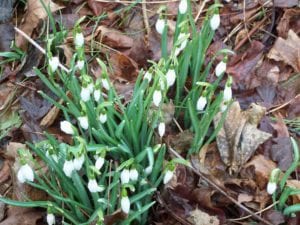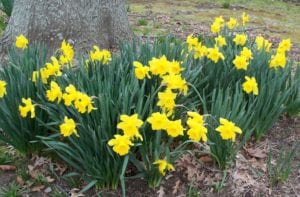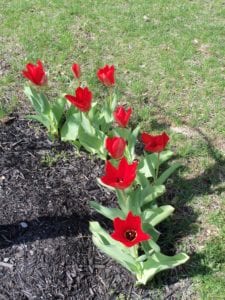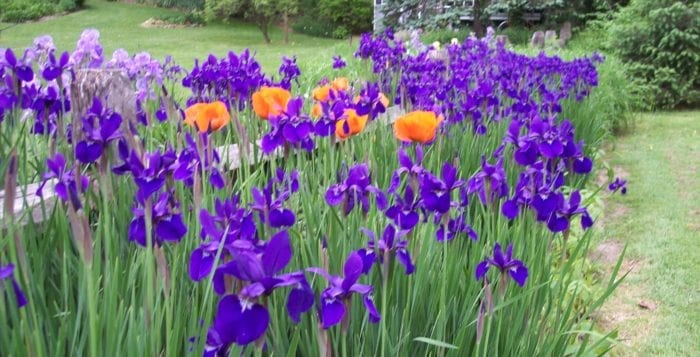Planting bulbs for spring blooms
By Ellen Barcel
Autumn is the time to plant your new spring flowering bulbs. They can be planted up until the ground freezes, usually in December. Buy the best quality you can afford and you will be rewarded with a great garden next spring.

• Don’t overlook the tiny bulbs. They’re not as showy as tulips and daffodils but are ideal in small areas and rock gardens. Crocuses, of course, come to mind, but I have windflowers in my garden coming back for decades. Other small bulbs include the super early white snowdrops, just four to six inches high, and anemone with their daisy-like flowers. There are also tiny varieties of the standards. ‘Lilac Wonder’ is a miniature tulip, lilac and bright yellow in color. ‘Pipit Daffodil,’ another miniature, is white and pale yellow. A unique, and small, daffodil is ‘Golden Bells,’ which produces a dozen or more flowers from each bulb. It’s just six to eight inches high and blooms in late spring to early summer.
• If you’re looking for very fragrant flowers, consider hyacinth. Although, like most spring flowers, the bloom is short-lived, their perfume is exquisite. ‘Gipsy Queen’ is a soft apricot color, ‘Jan Bos’ is a carmine-red, and ‘Woodstock’ is maroon. Some daffodils are also very fragrant. Check the package or the catalog description.

• If you do go with daffodils and tulips, consider at least some of the more unique ones. ‘Mount Hood’ is a daffodil that has gigantic white flowers, and ‘Green Eyes,’ also a white flower, has a green cup. ‘Exotic Mystery’ is almost completely a pale green while ‘Riot’ has reddish-pink cups. Among the tulips there are double flowers, a wide range of colors and even stripped ones. ‘Ice Cream’ is a really unique tulip. It has white center petals, surrounded by deep pink and green ones. It’s really exquisite. ‘Strawberry Ice Cream’ resembles a peony flower, in deep pink and green.
• Try some new (to you) and unusual bulbs. For example, ‘Candy Cane’ sorrel (oxalis) has white flowers tinged in red. They bloom in spring and even into summer. Another really unusual flower is the dragon flower. The bloom is maroon with a spathe that grows up to three feet. This is a big one and really unusual.

• Remember that certain bulbs are very attractive to squirrels, particularly tulips. There are several ways of handling this problem. One is to surround the tulip bulbs with daffodils. Squirrels don’t like daffodils and will generally stay away from them and the tulips they surround. A second way of dealing with this problem is to plant the tulip bulbs in wire cages. A third possibility, one I heard a planter recommend, is to overplant, that is, plant many more, possibly up to 25 percent more, bulbs than required. That way, the squirrels get some and some survive to grow in the spring.
• If you miss this planting window and the ground is frozen, there are several things you can do. The usual recommendation is to put the bulbs in the fridge until the ground thaws enough to plant them. You could also try planting them in pots and storing the pots in an unheated garage.
• The bulbs you plant this autumn will produce gorgeous flowers next spring. This is based on the professional growers’ treatment of the bulbs. They’ve grown them under ideal conditions, watered and fertilized them. To have them flourish in future years there are several things you need to do. One is to leave the green leaves on the bulbs after the blooms have faded. This is providing food for next year. You also need to add some fertilizer, again to help the bulbs for the following seasons. Make sure you water them in times of drought, even though by midsummer the leaves will have disappeared.
• Because spring bulbs basically disappear from the landscape by midsummer, they are ideal for beds where you intend to plant annuals. Plant the annual seeds in spring and by the time the bulbs have bloomed and faded, the annuals will have started to thrive.
• While you’re planting your spring flowering bulbs, consider also planting lilies, daylilies, peonies and hostas. All are perennials and will reward you next growing season.
Ellen Barcel is a freelance writer and master gardener. To reach Cornell Cooperative Extension of Suffolk County and its Master Gardener program, call 631-727-7850.







